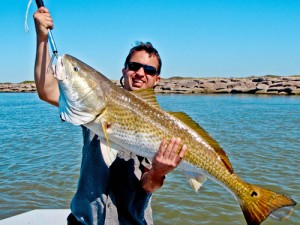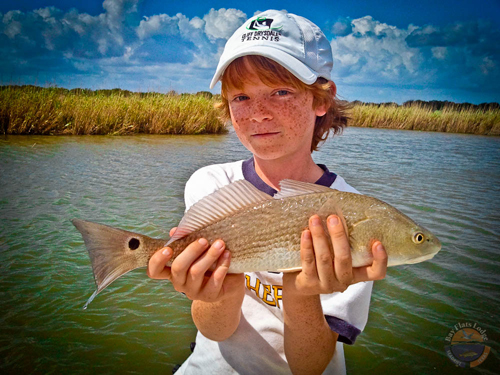When you and your fishing buddies are sitting around the lunch table talking about the month of October, I’d be willing to bet that the conversation tends to lean toward the subject of redfish quite rapidly. I assume this only because that is what everyone here at the Lodge wishes to discuss whenever I mention the month of October to them. This is because we’ve all come to realize that October is the month that marks the beginning of the annual redfish run, and that it is at this time of the year that the redfish will suddenly be hit with an uncontrollable urge to spawn. And although the female redfish are usually only ready to spawn every two to seven days, the male redfish (believe it, or not) are ready to spawn almost every night. Now then, depending upon where they happen to be located at the time of spawning, some of the female redfish can produce anywhere from one to two million eggs each spawn, and they’re able to do so in as little as every two to four days in many instances. There has been studies conducted showing evidence that a single female redfish being located in a more southern region may even produce as many as forty million eggs each spawning season. Now that’s a lot of eggs, and these red ladies are going to exert a lot of energy throughout the entire month of October. In fact, it’s during October that these fish will experience an excessive hunger and will exhibit a ravenous appetite. They will often become downright selfish in their acquisition of food amounts that are (sometimes) beyond necessity, even to the point of what some may refer to as being purely gluttonous. This spawn feeding pattern, or the grasping method the redfish use when dealing with food during this period, has been described as being absolutely violent in nature. And because the spawning reds will eat almost anything they think will satisfy their appetite, it’s this particular time of the year that happens to be one of my more favorite times for casting artificial baits almost exclusively on a daily basis.
We’re having a lot of fun with October’s redfish, as they have already become very prominent in our bay waters this month, and the recent action at Bay Flats has reflected that fact. The tides of late have allowed us to venture into the backcountry as required in order to find some of these fish, with the Killer Flats Minnow (manufactured by Texas Tackle Factory) producing the majority of the reds that we’ve found congregated in the lower water column of area shallow lakes. But due to the lack of typical frontal passages so far this fall, the fishing patterns have been somewhat similar to that of springtime, where morning coolness still can’t dominate over warm afternoons. And although I’ve focused a lot of my latest efforts deep within the heart of the back lakes which has recently produced reds to 28” and trout to 25”, I’ve still come to the realization that finding nervous mullet or diving pelicans to be of the utmost importance. So, my best bet for locating schools of mullet has been by me positioning my daily parties along shorelines consisting of patches of grass beds, where we’ve found redfish schooled-up tight to the shoreline, and usually populating some of the more murky water covering the grass and mud. The trout, on the other hand, are coming from over grass in some of the more decent green and clear water, and they seem to still prefer some of the sandier bottom structure. As you know, the air and water temps haven’t yet fallen enough to make the amount of heat absorbed and expelled by mud a contributing factor for the trout. Because of this, we’re still finding the trout bite over sand while throwing either top waters or plastics. And as we close the month of October and head into November, there will also be a couple other things that we’ll need to take into consideration if we wish to be proactive in our approach to successful fall fishing. The first thing to consider is the fact that the days will continue to get shorter, resulting in less sunlight hours each day. And secondly, keep in mind the importance of the imagery of your bait’s silhouette whenever you’re fishing these low-light conditions. It’s at this time of year that I usually start transitioning to dark-colored lures, and I’ll often start to experiment with some of the more common plastic suspending baits. These darker, suspending lures tend to imitate a silhouette more closely to that of a mullet, and the resulting darker silhouette will obviously mean better reflection of the bait against the upward sunlight.
Now then, when it comes to a world-class level of wing-shooting, it’s hard to beat the Seadrift and Port O’Connor areas for Pintail, Widgeon, Redheads, and a wide variety of Geese. For those of us in the south zone, the upcoming waterfowl season begins on November 5th this year, so let Bay Flats show you the hunt of a lifetime with an action-packed day of waterfowl hunting, fishing, or even both. Our “Blast & Cast” packages include morning shooting for ducks and geese followed by a relaxing afternoon on the water while bay fishing for trout, redfish, and flounder (or, returning to the blind to finish-out your duck limit with an afternoon of hunting). Either way, your afternoon is completely fun filled. And don’t forget to stay informed as to the latest Bay Flats news by signing-up on the Bay Flats Lodge website to receive your daily newsletter. Until next time, remember to practice CPR, “Catch, Photo, and Release”, whenever possible on trophy Trout and Reds…Guide Chris Martin, Port O’Connor/Seadrift region. www.BayFlatsLodge.com…1-888-677-4868.


